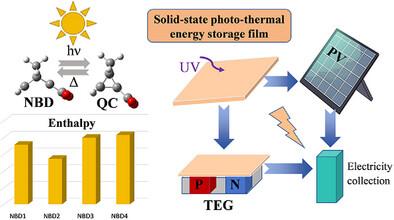Solid-State Norbornadiene Photothermal Films for Efficient Solar Energy Storage
IF 19
1区 材料科学
Q1 CHEMISTRY, MULTIDISCIPLINARY
引用次数: 0
Abstract
A solid-state photothermal (PT) energy storage film based on norbornadiene (NBD) molecules has been developed, which converts solar energy into chemical energy through photoisomerization reactions and releases it as thermal energy upon heating. The optical absorption, energy storage properties, tensile strength, and thermal conductivity of the four NBD molecules are evaluated. Among them, the NBD4 film demonstrates the highest thermal storage capacity, reaching up to 202 J g−1. In addition, the influence mechanism of different substituents and polystyrene (PS) concentrations on NBD is analyzed from a microscopic perspective. When integrated with photovoltaic (PV) cells, the solid-state PT energy storage films absorb UV light, lowering the PV cell temperature ≈5 °C while simultaneously storing UV photons as chemical energy. This results in ≈3% increase in overall system efficiency. After irradiation, the NBD film is additionally integrated with the thermoelectric generator (TEG). The stored energy is converted into electrical energy, enhancing thermoelectric conversion efficiency. The solid-state film proposed in this study effectively addresses the issues of poor thermal stability and leakage associated with liquid-based systems while remaining fully compatible with existing PV modules, thereby enhancing solar energy storage and heat release efficiency.

用于高效太阳能存储的固态降冰片二烯光热薄膜
研制了一种基于降冰片二烯(NBD)分子的固态光热(PT)储能薄膜,该薄膜通过光异构反应将太阳能转化为化学能,加热后以热能形式释放。评价了四种NBD分子的光吸收、储能性能、拉伸强度和导热性能。其中NBD4薄膜的蓄热能力最高,达到202 J g−1。此外,从微观角度分析了不同取代基和聚苯乙烯(PS)浓度对NBD的影响机理。当与光伏(PV)电池集成时,固态PT储能膜吸收紫外光,降低PV电池温度≈5°C,同时将紫外光光子作为化学能存储。这将使整个系统效率提高约3%。辐照后,NBD膜与热电发生器(TEG)集成。储存的能量转化为电能,提高了热电转换效率。本研究中提出的固态薄膜有效地解决了与液体系统相关的热稳定性差和泄漏问题,同时与现有光伏组件完全兼容,从而提高了太阳能储能和放热效率。
本文章由计算机程序翻译,如有差异,请以英文原文为准。
求助全文
约1分钟内获得全文
求助全文
来源期刊

Advanced Functional Materials
工程技术-材料科学:综合
CiteScore
29.50
自引率
4.20%
发文量
2086
审稿时长
2.1 months
期刊介绍:
Firmly established as a top-tier materials science journal, Advanced Functional Materials reports breakthrough research in all aspects of materials science, including nanotechnology, chemistry, physics, and biology every week.
Advanced Functional Materials is known for its rapid and fair peer review, quality content, and high impact, making it the first choice of the international materials science community.
 求助内容:
求助内容: 应助结果提醒方式:
应助结果提醒方式:


